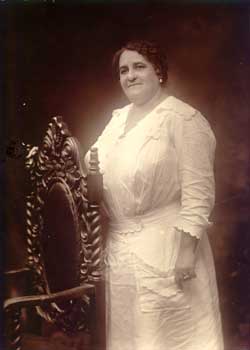BLACK SOCIAL HISTORY
Maggie L. Walker
.
Maggie Lena Walker (July 15, 1864-December 15, 1934) was an African-American teacher and businesswoman. Walker was the first female bank president of any race to charter a bank in the United States.[1] As a leader, she achieved successes with the vision to make tangible improvements in the way of life for African Americans and women. Disabled by paralysis and limited to a wheelchair later in life, Walker also became an example for people with disabilities.
Walker's restored and furnished home in the historic Jackson Ward neighborhood of Richmond, Virginia has been designated aNational Historic Site, operated by the National Park Service.
Childhood, education
According to biographical material she supplied, Walker was born as Maggie Lena Mitchell in Richmond, Virginia, to William Mitchell and Elizabeth Draper Mitchell two years and two months after the end of the American Civil War. Census information, as well as a diary passage saying that she was four years old on her mother's wedding on May 1868, set the date back to 1864 or 1865.[2] Her mother was a former slave and an assistant cook in the Church Hill mansion of Elizabeth Van Lew, who had been a spy in theConfederate capital city of Richmond for the Union during the War, and was later postmistress for Richmond. Her father was a butler and writer.[3]
The Mitchell family moved to their own home on College Alley off of Broad Street nearby Miss Van Lew's home where Maggie and her brother Johnnie were raised.[4] The house was near the First African Baptist Church which, like many black churches at the time, was an economic, political, and social center for the local black community.[5] After the untimely death of William Mitchell, Maggie's mother supported her family by working as a laundress. Young Maggie attended the newly formed Richmond Public Schools and helped her mother by delivering the clean clothes.
Teacher, mother, leader
She taught grade school for three years until 1886, when she married Armstead Walker Jr., a brick contractor. Her husband earned a good living, and she was able to leave teaching to take care of her family and her work with the Independent Order of St. Luke. Maggie and Armstead Walker Jr. had sons, Russell and Melvin, and purchased a home in 1904.
When she was fourteen years old, young Maggie joined the local council of the Independent Order of St. Luke. This fraternal burial society, established in 1867 in Baltimore, Maryland, administered to the sick and aged, promoted humanitarian causes and encouraged individual self-help and integrity. She served in numerous capacities of increasing responsibility for the Order, from that of a delegate to the biannual convention to the top leadership position of Right Worthy Grand Secretary in 1899, a position she held until her death.
Businesswoman, banker
In 1902, she established a newspaper for the organization, The St. Luke Herald. Shortly thereafter, she chartered the St. Luke Penny Savings Bank. Mrs. Walker served as the bank's first president, which earned her the recognition of being the first black woman to charter a bank in the United States. Later she agreed to serve as chairman of the board of directors when the bank merged with two other Richmond banks to become The Consolidated Bank and Trust Company, which grew to serve generations of Richmonders as an African-American owned institution.
Tragedy struck in 1915 when her husband was accidentally killed, leaving Mrs. Walker to manage a large household. Her work and investments kept the family comfortably situated. When her sons married they brought their wives to 1101⁄2 East Leigh Street, her home in Richmond's Jackson Ward district, the center of Richmond's African-American business and social life around the start of the 20th century.
Mrs. Walker received an honorary Masters degree from Virginia Union University in 1923, and was inducted into the Junior Achievement U.S. Business Hall of Fame in 2002
Maggie L walker was a loving and caring person if she alive she would love to keep on helping children's to do work and open more and more banks
Heritage
In Maggie's honor Richmond Public Schools built a large brick high school adjacent to Virginia Union University. Maggie L. Walker High School was one of two schools in the area for black students, during the period of racial segregation in schools. The other was Armstrong High School. After generations of students spent their high-school years there, it was totally refurbished in the late 20th century to become the regional Maggie L. Walker Governor's School for Government and International Studies.
The National Park Service operates the Maggie L. Walker Historical Site at the former Jackson Ward home. In 1978 the house was designated a National Historic Site and was opened as a museum in 1985. The site states that it "commemorates the life of a progressive and talented African-American woman. She achieved success in the world of business and finance as the first black woman in the United States to charter and serve as president of a bank, despite the many adversities. The site includes a visitor center detailing her life and the Jackson Ward community in which she lived and worked and her residence of thirty years.The house is restored to its 1930's appearance with original Walker family pieces." [6]
The St. Luke Building held the offices of the Independent Order of St. Luke, and the office of Maggie L. Walker. The office is preserved as it was at the time of her death in 1934.[7] The building was listed on the National Register of Historic Places in 1982.[8]







































































































No comments:
Post a Comment